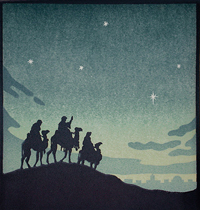 For centuries astronomers have speculated about the famous Star of Bethlehem, which the three Magi (the three wise men/the three kings) followed to the place of Christ’s birth. Of course, the star may defy scientific explanation altogether, and be viewed as a miracle. Nevertheless, various astronomical theories have been proposed, including that the star may have been a comet, or a supernova (an exploding star), or a “planetary conjunction” (a gathering of planets in one part of the sky). In this column, we’ll examine two of today’s most popular theories, both of which hold that the planet Jupiter played a key role.
For centuries astronomers have speculated about the famous Star of Bethlehem, which the three Magi (the three wise men/the three kings) followed to the place of Christ’s birth. Of course, the star may defy scientific explanation altogether, and be viewed as a miracle. Nevertheless, various astronomical theories have been proposed, including that the star may have been a comet, or a supernova (an exploding star), or a “planetary conjunction” (a gathering of planets in one part of the sky). In this column, we’ll examine two of today’s most popular theories, both of which hold that the planet Jupiter played a key role.
First, though, it’s useful to recall what the Bible says about the most famous star in history:
After Jesus was born in Bethlehem in Judea, during the time of King Herod, Magi from the east came to Jerusalem and asked, “Where is the one who has been born king of the Jews? We saw his star when it rose and have come to worship him.”
When King Herod heard this he was disturbed, and all Jerusalem with him. When he had called together all the people’s chief priests and teachers of the law, he asked them where the Messiah was to be born. “In Bethlehem in Judea,” they replied, “for this is what the prophet has written:
“‘But you, Bethlehem, in the land of Judah, are by no means least among the rulers of Judah; for out of you will come a ruler who will shepherd my people Israel.’”
Then Herod called the Magi secretly and found out from them the exact time the star had appeared. He sent them to Bethlehem and said, “Go and search carefully for the child. As soon as you find him, report to me, so that I too may go and worship him.”
After they had heard the king, they went on their way, and the star they had seen when it rose went ahead of them until it stopped over the place where the child was. When they saw the star, they were overjoyed. On coming to the house, they saw the child with his mother Mary, and they bowed down and worshiped him. Then they opened their treasures and presented him with gifts of gold, frankincense and myrrh. And having been warned in a dream not to go back to Herod, they returned to their country by another route.
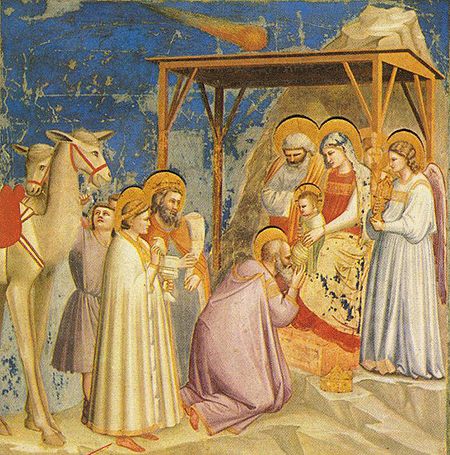
If you Google “Star of Bethlehem,” the Web site of a best selling DVD, The Star of Bethlehem, ranks at the very top. The DVD features American attorney, Sunday school teacher, and amateur astronomer Rick Larson, who has conducted extensive research into the scientific, historical and theological aspects of the Star of Bethlehem.
After a careful review of scripture, Larson identifies nine characteristics of the star that, he believes, any scientific theory of the star must meet in order to be compliant with Christian belief. For example, we can see from Matthew 2:1-12 that the star signified the birth of a king, that it was associated with the Jewish nation, and that, “it stopped over the place where the child was” – Bethlehem.
Larson then draws on his study of ancient history to address the all-important issue of the year that King Herod died. According to Matthew 2, after the birth of Jesus, an angel appeared to Joseph in a dream, urging Joseph to flee Israel and take Mary and the infant Jesus to Egypt so as to avoid the wrath of Herod, who had issued orders that all male children in his realm under the age of two be executed. Later in Matthew 2, an angel informs Joseph that Herod has died, and that it is safe to return to Israel. So the argument goes that we should subtract two years from the year of Herod’s death to estimate the year Jesus was born. Knowing Jesus’ estimated year of birth allows astronomers to run computer simulations of the positions of the stars and planets as they appeared in the night sky during the approximate time frame of Jesus’ birth.
Most historians and biblical scholars put Herod’s death at around the year 4 BC, meaning Jesus would have been born sometime around 6 BC. But Larson points to recent historical research arguing that Herod died in 1 BC, which would place Jesus’ birth year around 3 BC.
Using modern astronomical software, Larson then runs computer simulations of the night sky over the Middle East in 3 and 2 BC and reaches two remarkable results – both involving the planet Jupiter.
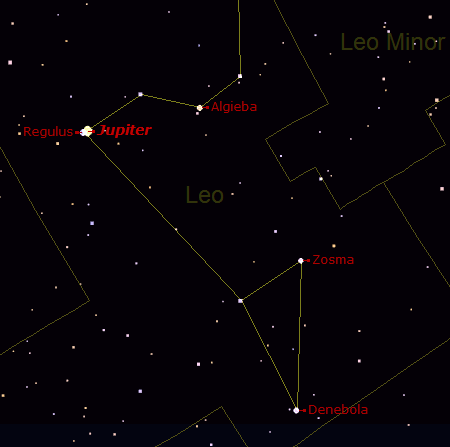
Figure 2 shows part of the night sky from Jerusalem in mid-September of 3 BC. Jupiter, known as the “King Planet” (from classical mythology) is in conjunction with (i.e., is close to) the star “Regulus,” known as the “King Star.” Furthermore, Regulus is in the constellation (area of the night sky) “Leo,” which represents a lion, which was the symbol of Judah.
Furthermore, Larson notes, the planets in the night sky move relative to the ‘fixed’ stars: If you note the position of, say, Jupiter relative to stars such as Regulus from night to night, then you’ll note that Jupiter generally moves eastward across successive night skies. However, occasionally, Jupiter will seemingly halt its eastward movement, and begin moving westward across successive night skies. (This is an optical effect – called “retrograde motion” – resulting from the fact that Earth’s orbit around the sun lies within Jupiter’s orbit around the sun: See Figure 3.) As Jupiter switches from moving eastward to moving westward (or vice versa), Jupiter appears to be stationary relative to the stars. In this way, Jupiter appeared to stop “over the place where the child was,” as we read in Matthew 2.
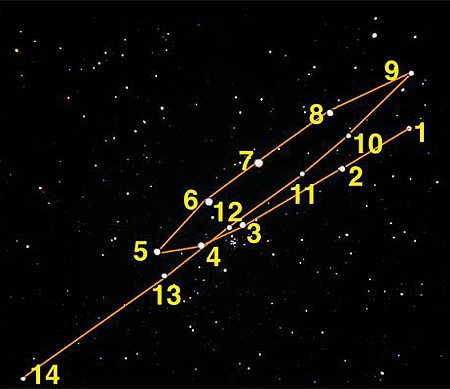
But, Larson argues, this conjunction of Leo with Regulus may have marked the conception of Jesus. If we run the computer simulation of Jerusalem’s night sky forward nine months into June of 2 BC, we find that Jupiter and the planet Venus – two of the brightest planets in the night sky – come into extremely close conjunction, so much so that the two planets appear together as one, very bright ‘star’ in the night sky!
So the conjunction of Jupiter with Regulus in 3 BC, and/or the conjunction of Jupiter with Venus nine months later in 2 BC, may very well have been the star the Magi followed.
If we return to the Google search results for “Star of Bethlehem,” we find the Web site of professional astronomer Michael Molnar, who takes a different approach to the star of Bethlehem. In his book, The Star of Bethlehem: The Legacy of the Magi, Molnar explores not only the Biblical account of the star, but also the point of view of the Magi, whom Molnar argues were astrologers/astronomers: In the ancient Roman world, astrology and astronomy were indistinguishable. The Magi were held in high esteem in Roman culture, and were considered to be very knowledgeable, indeed, wise men.
Molnar, who does not believe in astrology, nevertheless has extensively researched the astrological beliefs prevalent in the Roman world. He argues that modern astronomers who think about the Star of Bethlehem make a mistake by focusing on what spectacular displays may have appeared in the night sky around the time of Jesus’ birth, such as the appearance of a very bright star. The focus on amazing heavenly displays is a bias of relatively modern astronomers, Molnar argues. The Magi of ancient Rome, Molnar explains, were primarily concerned with the logic of their astrological system, which placed primary emphasis on the locations and arrangements of the planets in the night sky – the sequence of planets in the night sky, what constellations they were in, how far above the horizon they appeared at sunrise, etc.
So, for example, the fact that Jupiter and Venus were so close to one another that they appeared as one, very bright star would not necessarily be significant to the Magi. Rather, the Magi would be much more interested in knowing whether Jupiter was to the east of Venus or to the west of Venus, the constellation(s) in which the two planets were located, and how high above the horizon the two planets appeared at sunrise.
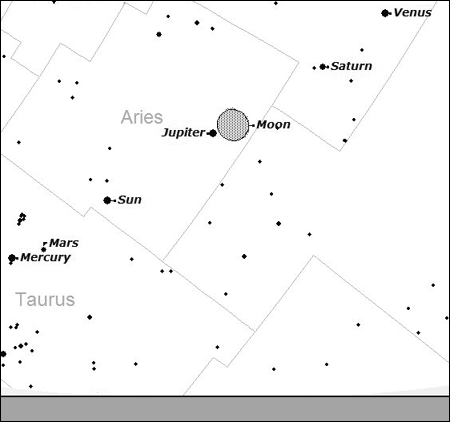
Accepting the consensus view of most scholars that Herod likely died in 4 BC, Molnar considers the positions of the planets in the night sky two years earlier – in 6 BC – and finds a particular arrangement of the planets Jupiter, Saturn, Venus, Mars and Mercury, together with the Moon and Sun, that would have been of great astrological significance to the Magi, indicating that a king was being born. Furthermore, the centering of this particular planetary arrangement in and around the constellation Aries was significant, in part because in Roman-era astrology Aries was the sign of Judea. So to the Magi, the arrangement of the stars and planets in 6 BC led them to believe that a great king was born in Judea. Moreover, we should bear in mind Jupiter’s retrograde motion, as well as the spirit of revolution in the air at the time – the notion that a messiah would soon lead the Jewish people in revolt against the Roman Empire. All of these factors combined, then, would naturally have induced the Magi to travel to Jerusalem – the capitol city of Judea – to inquire as to the whereabouts of the newborn king.
So whether we take the more Biblically-oriented analysis of Larson, or the more astrologically-oriented analysis of Molnar, we find compelling scenarios that support the notion that the Star of Bethlehem was a real, historical event.